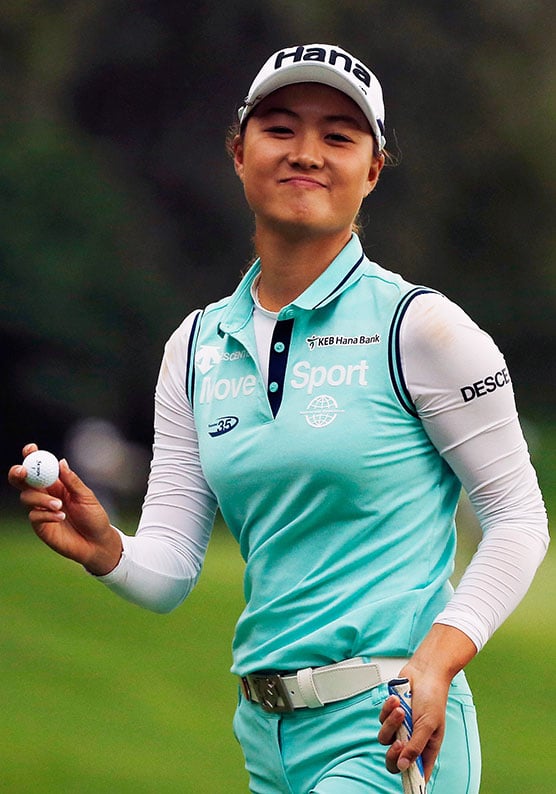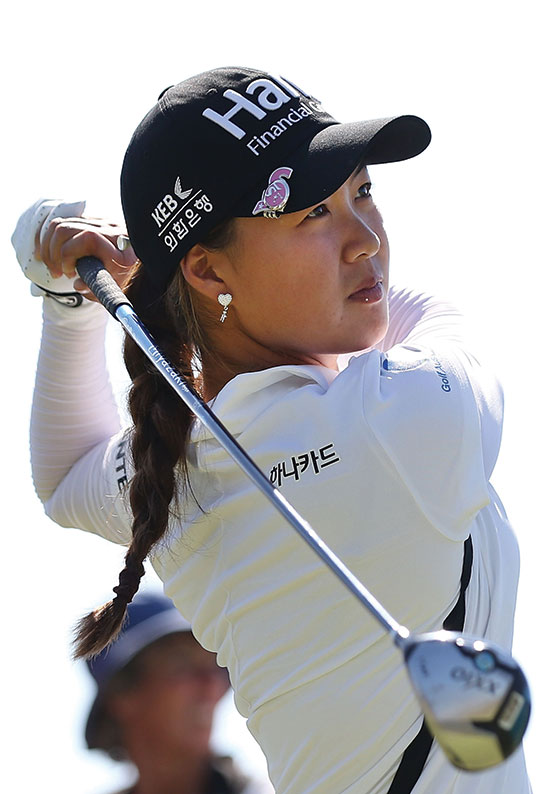Minjee Lee’s first season on the LPGA Tour will go down as a raging success. But it was anything but that last April. She had missed three cuts in a row, sacked two caddies and broken 70 only once all year. And she was homesick.
A downcast Lee arrived at Los Angeles Airport with her mother, Clara, carrying seven pieces of luggage. Can you imagine travelling with seven bags and suitcases? Forget about being weighed down by expectations. Minjee was literally weighed down. On domestic travel in the United States, it would be depressing.
It’s a tribute to her support network – coach Ritchie Smith, biomechanist Ryan Lumsden and Irish physiotherapist Orlaith Buckley – that they were able to get her mind back on the job over the next four days. Five weeks later she won the Kingsmill Championship to become the seventh golfer to win on the LPGA Tour before their 19th birthday.
After a slow start, a good middle and solid finish, the teenager from Royal Fremantle Golf Club had produced one of the finest seasons by an Australian rookie in America – not as brilliant as Karrie Webb’s trailblazing season of 1996, but as good (if not better) than the debuts of Jan Stephenson (1974) and Marc Leishman (2009).

Room For Improvement
With one victory and six finishes in the top 10, Lee’s results drew attention to her game. In a straw poll of players conducted by LPGA.com, Lee was recognised for having the ‘Best Swing on the LPGA Tour’. Her name was mentioned most often among the tour’s sweetest swingers, such as Na Yeon Choi, Jessica Korda and Hyo Joo Kim.
Flattering, but her Perth-based coach Ritchie Smith doesn’t agree. He looks at Lee’s swing critically, because that’s his job. He prefers the smooth rhythmic swing of Korea’s Choi, an endorsement supported by Hall of Famer Juli Inkster.
So while it’s a nice compliment to be admired, Smith sees room for improvement. He doesn’t like Minjee’s attack on the ball, which isn’t consistent enough to be a truly great action. That said, her swing is really good dynamically and it certainly looks better than a lot of the other girls out on tour.
Hence, Smith is optimistic about 2016, believing Lee can push into the world’s top 10 on the Rolex Rankings for women’s golf. But for that to happen, she has to address some weaknesses.
“Technically, she gets the club too far caught behind her. So the path becomes a bit of an issue and the club gets a little bit unstable because of it. The coordination of body and arm movement sometimes – well, not sometimes, all the time – is a little bit inconsistent.”
Lee also needs a lower ball flight with her tee shots and irons. And that’s the coordination issue. If the club gets caught behind, then the clubhead is shallow through the point of impact. Loft is increased and the result is a higher ball flight.
In Total Driving, which combines distance and accuracy, Lee ranked an impressive 6th on the LPGA Tour. With an Average Driving Distance of 259.6 yards, Lee is one of the longer hitters in women’s golf (17th). It stands to reason that if she can improve her Driving Accuracy (71st, hitting 71.9% of fairways), Lee can become one of the dominant players in women’s golf.
To do so she’ll have to produce more Rounds in the 60s. In this statistical category, Inbee Park and Lydia Ko shoot in the 60s more than 50 per cent of the time. Lee achieved the mark 31 times from 104 rounds (29.8%). And while she can break par 55.8 per cent of the time, it’s a long way behind Park (80.9%) and Ko (77.4%) who lead the tour for Rounds Under Par.
Pitching and chipping is another concern of Smith. “I don’t believe she gets enough spin on the ball, which we can relate back to the body coordination with the arms.”
Lee also lost a bit of the feel of holing putts. She can demolish a field if she putts well, which we saw at Kingsmill when she putted brilliantly over the last 18 holes and won quite comfortably. “Her putting fails her when she’s not under pressure,” concedes Smith. “And her putting’s great when she is. Whether that’s a mental thing, I’m not sure.”
It may be attitudinal. Lee appears to thrive on competition, coming down the stretch of a tournament. She also tends to be more focussed on a putt to save par, whereas she’s not as desperate when it’s a putt for birdie.
This is borne out statistically in Putts Per GIR, which measures the average number of putts per green in regulation. Lee ranked 23rd on tour – not bad. The top-three in this birdie-making category were Stacy Lewis, Ko and Park and it’s no coincidence they are the top three on the Women’s World Golf Rankings.
However, there’s enormous upside to Lee’s game from tee to green. “I think once we actually see her putt well and take advantage of her ballstriking, she’ll be very, very good,” Smith predicts.

Challenge #1
More demands on her time
Lee, who turns 20 in May, will face a different set of challenges in 2016. As her profile grows, there will be an expectation to promote the LPGA Tour. She can’t fly under the radar anymore or use the excuse she’s only a rookie.
And whether she accepts it or not, Lee has overtaken Karrie Webb to become Australia’s top-ranked female golfer. With that comes an obligation to be the figurehead of the sport in this country. It will take time to sink in.
When she was 17 and playing the US Women’s Open, Smith suggested she go over and sign 30 autographs. Minjee’s response was: “Well why, why do that? No one wants my autograph. What’s the point of signing an autograph? What does that do?”
Others have remarked that Lee is uncomfortable talking about herself – she just doesn’t understand what the big fuss is all about. She gives the impression she doesn’t like to do media work, to the point of being difficult.
As she matures, Lee will come to realise her responsibilities. Let’s hope she will be open and communicate with the media and interact with the galleries. The last thing the LPGA Tour needs right now is another popular player walking around under management company orders.
Challenge #2
Choosing the right schedule
Lee was one of the ironwomen of the LPGA Tour last year when she played 29 out of a possible 31 events. Only one player teed it up more often (Chella Choi, 31 tournaments). Lee played 104 rounds of golf, not including pro-ams and practice rounds.
It’s worth noting the world’s top-five players competed in between 24-26 events. Webb played 22 tournaments. So to avoid burnout, Lee needs to be much more selective in the events she plays.
On top of that, Lee didn’t have a fixed abode in America last year. She basically commuted from tournament to tournament, staying at other people’s homes and hotels. For a large part of the year, Lee was billeted at tournaments or spent time with friends.
That won’t happen in 2016 and it should lead to a much more settled performance. Lee will have a lot better idea of which courses she likes and what courses suit her. And she’ll have better tee times. (Rookies get grouped with other rookies and qualifiers, which isn’t as conducive to good scoring.)

Challenge #3
National pride on the line
Golf returns to the Olympics for the first time in more than a century in Rio. The women’s competition in Brazil runs from August 15-21. It could prove to be a pleasant distraction or a needless diversion for an elite golfer. (Adam Scott has already indicated it’s not high on his list of priorities.) As Australia’s leading player, Lee will be the subject of much focus given Australia’s insatiable quest for medals.
She will also be the lynchpin for Australia at the second edition of the International Crown (July 21-24). The top-four players from eight countries compete in the biennial teams’ event. Australia will be seeking a better result in Chicago after finishing last in the inaugural event. Much will depend on Lee.
Without her and Webb, Australian Ladies Professional Golf delivered a poor performance at The Queens in Japan last December. That matchplay event pitted teams from the Ladies European Tour, LPGA of Japan, Korean LPGA and the ALPG against one another. The Australians won just two and halved one of their 17 matches to finish bottom.
Challenge #4
The right support network
A positive influence around Lee has been caddie Jeremy Young, the husband of former LPGA Tour member Heather Young. After struggling to find synergy with a bagman in the early part of last season, the partnership with Young appears to have gelled judging by Lee’s results since May.
Another constant throughout 2015 was Lee’s mother Clara, an outstanding golfer in her own right. Having a close family member is a common occurrence on the LPGA Tour, especially among Korean-raised players.
As an 18-year-old professional, it was really important for Minjee to have her Mum out on tour. But further down the track it may hinder her progress is she stays there. “Players need to get mentally stronger and that won’t happen with her Mum there every week travelling with her,” according to one observer.
In football parlance, it’s often stated that if you’re not improving, then you’re going backwards. If Minjee Lee is to avoid a dose of the second-year blues, she will have to maintain the desire to succeed and use her time efficiently on and off the course. The danger would appear to be expecting improvements to come with experience.
Throughout the whole of 2015, there was one characteristic that impressed her coach and leaves him confident that Lee is set for the long haul.
“Resilience,” says Smith. “She’s really resilient. She’s not afraid of winning, she’s not afraid of being right there at the pointy end. I think she’s a tough kid. Even though she’s a happy kid, she’s a tough kid.”

Ko, the Headline Act
World No.1 Lydia Ko [above] will defend the ISPS Handa Women’s Australian Open when the national championship returns to Adelaide for the first time in 21 years.
The Grange Golf Club’s West Course will host the flagship event on the ALPG Tour from February 18-21. It’s estimated South Australia’s visitor economy will be boosted by $3.7 million from staging the Women’s Open.
With prizemoney of $US1.3 million, the jointly co-sanctioned event with the LPGA Tour and Ladies European Tour has the summer’s richest purse in Australian golf.
The local challenge will be led by five-time winner Karrie Webb and Australia’s top-ranked female golfer Minjee Lee, who was the leading Australian at last year’s Open at Royal Melbourne where she finished in a tie for seventh.
The 2016 ALPG schedule begins with pro-ams at Moss Vale (Jan 7-8) and Mount Broughton (Jan 9-10) in the NSW Southern Highlands. It moves to Sydney for events at Oatlands (Jan 14-15), Castle Hill (Jan 19), Pennant Hills (Jan 21-22) and Long Reef (Jan 25).
The bigger tournaments begin in February when Marianne Skarpnord makes a title defence of the Oates Victorian Open at Thirteenth Beach on the Bellarine Peninsula (Feb 4-7). It’s followed by the ISPS Handa New Zealand Women’s Open at Clearwater Golf Club in Christchurch where Ko is the defending champion (Feb 11-14).
The ALPG Tour moves back to Australia for the Women’s Australian Open at The Grange and the RACV Ladies Masters at Royal Pines Resort where Su Oh will defend the title she won as a rookie (Feb 25-28).
The season concludes with the Brisbane Invitational at McLeod Country Golf Club (March 1-2) and a one-dayer at Yamba in Northern NSW (March 4).
